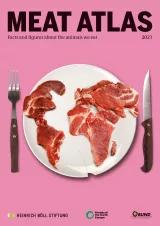
Pesticide applications are on the rise across the globe. Some of the most dangerous substances have been banned in the
European Union, but are still being used on a large scale in other parts of the world. Many are intended for the cultivation
of soybean and maize, which are destined mainly for use as livestock feed.

The worldwide use of pesticides has doubled since 1990, with over 4 million tonnes of active ingredients now applied every year to control weeds, insects and other plant pests. The quantities of pesticides traded are far higher than this, because the active ingredients are mixed with other chemicals and water to make them easier to apply and to boost their effectiveness. While applications have stagnated in many parts of the European Union over the last 30 years, they have increased sharply elsewhere in the world.
This increase results in part from the rising global demand for meat. This in turn stimulates the demand for protein-rich feed made from soybeans, the main producers of which are the USA, Brazil and Argentina. These three countries are among the world’s biggest pesticide users. The figures for China are contradictory. The country’s statistics office has given the Food and Agriculture Organization of the United Nations a figure of 1.7 million tonnes – over 40 percent of global consumption. But an official Chinese specialized authority reports just 300,000 tonnes. It is unclear if the two numbers can be compared. Regarding herbicides, which are used to control weeds, the USA uses more than 250,000 tonnes, Brazil nearly 230,000 tonnes, and Argentina 161,000 tonnes. Together, that is nearly 70 percent of the global reported consumption.
Agrochemicals are used to produce many crops in these countries. Soybeans, most of which are processed into livestock feed, play a special role. In Brazil, 52 percent of all pesticide sales are for soybean production. Rising in parallel to soy production, which has increased almost sixfold since 1990, is pesticide use: nine times as much pesticide is sprayed today in Brazil as 30 years ago.
The rise in pesticide consumption in Brazil and Argentina is linked to the introduction of genetically modified soybeans at the end of the 1990s. These plants are resistant to glyphosate, a broad-spectrum systemic herbicide. Glyphosate can be sprayed on soybeans while they are growing in the field to destroy any weeds that compete with the crop. But the more glyphosate is applied, the likelier it is that the weeds will become resistant to the spray – forcing farmers to spray even more, and to use different types of weedkillers. A vicious circle ensues.
It is the pesticide producers that reap the rewards. The main beneficiaries are Syngenta, headquartered in Switzerland; Bayer and BASF in Germany; and Corteva and FMC in the USA. These five firms control over 70 percent of the world market for pesticides, which was valued at an estimated 60 billion US dollars in 2019. Syngenta is the global market leader, accounting for one quarter of industry sales alone.
The pesticides sold by the five firms vary in their mode of action as well as in the risks they pose. Non-governmental organizations estimate that in 2018, the firms generated a combined 35 percent of global sales from substances that are particularly damaging to humans or the environment. The NGO Pesticide Action Network classifies such substances as “highly hazardous” on the basis of assessments by various national and international authorities.
These companies are grouped into a trade association known as “CropLife International”. They do a particularly good business in highly hazardous pesticides for growing feed crops. Applications for soy and maize account for almost half their sales of such pesticides. In Brazil, their biggest market, soybean cultivation accounts for almost two-thirds of those sales.
The top seller is glyphosate, classified by the International Agency for Research on Cancer as “probably carcinogenic”. Besides Bayer AG, which acquired most of its glyphosate business through its purchase of the US company Monsanto, hundreds of other companies have long since sold this controversial product. For soybean cultivation in Brazil alone, 246 glyphosate-containing pesticide products from 50 different companies are approved for sale.
Other highly dangerous substances are also in use. Paraquat, for example, is popular. Because of its high acute toxicity, this herbicide, developed in 1955, has been banned in over 50 countries, including the European Union, Switzerland, China and, since September 2020, Brazil. Syngenta and other firms nonetheless still sell it in countries where regulation and enforcement are weaker. German and US companies also continue to trade in many pesticides that are banned in their home markets because of known risks. The German firm Bayer AG sells insecticides in South America that are banned in the European Union due to their high bee toxicity.
Many of these pesticides are produced in the European Union and then exported. Under the EU-Mercosur trade agreement, this trade could increase further because the customs duties for chemical products – including pesticides – are to be reduced. Nonetheless, the European Commission wants to stop the production of chemicals for export if they are banned in the EU. A first success is in France, where such a ban will come into force in 2022. Exports from Switzerland were tightened in 2021, and the export of five pesticides is now banned.


